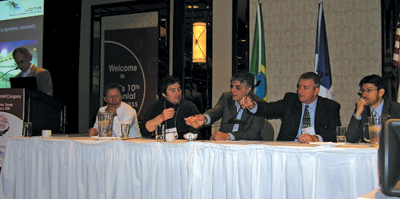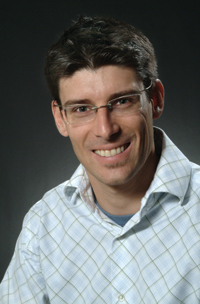
The world sees Canadian chiropractic researchers as the profession’s upper echelon of scientists in this field. It is a widely known – and, perhaps, agreed upon – point, that
achieving affiliations with universities affords greater opportunity
for, and lends more credibility to, research efforts in any field.
The world sees Canadian chiropractic researchers as the profession’s upper echelon of scientists in this field.
It is a widely known – and, perhaps, agreed upon – point, that achieving affiliations with universities affords greater opportunity for, and lends more credibility to, research efforts in any field. By working within a university setting, the knowledge obtained through research can be disseminated to others in the academic environment, thus fostering awareness, discussion, understanding and, hopefully, giving rise to new ideas for further development. The profession of chiropractic – particularly in Canada
– has grasped these concepts and taken them to unprecedented levels, making Canadians stand out as leaders in university-based chiropractic research achievements.
 |
| Canadian DC scientists introduced by Dr. Alan Gotlib, CCRF president: Left to right: Dr. Alan Gotlib, Dr. Martin Normand (Quebec), Dr. Jean-Sebastien Blouin (British Columbia), Dr. Greg Kawchuck, (Alberta), Dr. Mark Erwin (Ontario), Dr. Martin Descarreaux (Quebec)
|
But, how much stronger is the link between flourishing research and the university setting if the area of study is anchored within the institution as a distinct department providing students with training in all aspects – including research methodology – from Day one? In this issue of Canadian Chiropractor, Dr. Martin Descarreaux, professor and recipient of the Chair of Chiropractic Research at the Université du Québec à Trois-Rivières, (UQTR) talks to us about the only research program in Canada that is embedded within a university-based chiropractic program. Dr. Descarreaux addresses how this affiliation has benefited the research activities of the chiropractic scientists at UQTR, and influenced the perception towards, and involvement within, research for the students who are in a university environment throughout their chiropractic training.
Canadian Chiropractor: Describe the emergence and direction of research within the chiropractic program at UQTR.
 |
|
| Dr. Martin Descarreaux, professor and recipient of the UQTR Chair of Chiropractic Research
|
Dr. Descarreaux: Our research program includes studies aimed at the understanding of neuromuscular control, spine adaptation and rehabilitation as well as the neurophysiologic effects of spinal manipulation. The characterization of the neurophysiological and biomechanical effects of spinal manipulations is utmost amongst the Chair’s research themes. To date, researchers at UQTR (myself and Mathieu Piché, DC, PhD) have studied the effect of spinal manipulation on neuromuscular responses of the lumbar spine and the effect of spinal manipulation on modulation of autonomic functions. We hope that our research will help others understand the biological basis behind the clinical improvement observed in the everyday chiropractic practice.
A multidisciplinary group of investigators are involved in the Chair and associated research unit [Neuromuscular adaptation research group (GRAN)] activities. Dr. Martin Descarreaux, Dr. Martin C. Normand, Dr. Mathieu Piché and Dr. Pierre Boucher from the chiropractic department, as well as colleagues from the kinesiology, podiatry and psychology departments, have been collaborators for many years. This group is actually actively involved in fundamental and applied low back pain and neck pain research. Such multidisciplinary collaborations have facilitated access to numerous research resources such as surface electromyography (EMG) force plate, three-dimensional motion capture system, the exercise physiology laboratory and the neuropsychological evaluation laboratory.
CC: Discuss the Chiropractic Research Chair and how achieving and holding it has enhanced your own research efforts, as well as the research efforts of colleagues and students within the chiropractic program.
Dr. Descarreaux: In the past years, the chiropractic research chair, and its associated research units, have played an increasing role in the training of future chiropractic researchers. Each year the group welcomes undergraduate and graduate students with diverse academic backgrounds.
The Chiropractic Research Chair at the UQTR was inaugurated in August 2006. It was initially attributed funding of $250,000 in operating grants, and $230,000 dedicated to the acquisition of research equipment. The “Fondation de Recherche Chiropratique du Québec” and Platinum Systems, a firm specializing in clinical management software, were the main financial contributors to the chair. In the last two years, the Canadian Chiropractic Protective Association, the Canadian Chiropractic Association and the Foundation for Chiropractic Education and Research, have also helped in the development of the chair.
The chiropractic chair and its associated funding have led to the development and improvement of our laboratory infrastructures. Both our neuromechanics and neurophysiology laboratory are now equipped with state-of-the-art research equipment. The chair operating grants and the creation of the neuromuscular adaptation research group (GRAN) allowed us to recruit and train undergraduate and graduate students. We are currently directing or co-directing eight graduate students. All students trained in our laboratory are encouraged to participate in the various phases of the research process. As portrayed by the publications, platform and poster presentations, by the students’ participation in our journal club and the numerous undergraduate scholarships obtained since 2002, training of young researchers in an interdisciplinary environment is at the centre of our research team dynamic.
CC: How has being affiliated with a university benefited the development of chiropractic research at UQTR?
Dr. Descarreaux: Being in a university setting may have been the key in the development of chiropractic research in Trois-Rivières. Such a “status” ensures that more time is dedicated to research activities, financial and technical support (examples: engineers, statisticians, etc.), scientific support (ethics committee and resources, support for grant application, internal funding of research), and most important of all, the possibility of working closely with researchers of diverse backgrounds – kinesiology, psychology, neurosciences, engineering, social sciences, etc. For me, being in a university is a completely positive partnership.
CC: What goals would you like to see the UQTR program achieve, with respect to research, over the next five years?
Dr. Descarreaux: In the coming years, chiropractic research at UQTR must strive to achieve a variety of goals in order to maintain the already established research program, while expanding our field of research. These are:
- obtain external funding from provincial and federal agencies;
- continue to train for master’s degree and increase training of PhD students;
- hire three to four DCs, PhDs or PhDs in research fields related to chiropractic (biomechanics, neurosciences, epidemiology);
- create a research environment where basic science and clinical science researchers can interact and collaborate in order to maximize the knowledge transfer to the practitioner;
- strive to become a prominent chiroropractic research centre, where researchers from the chiropractic community would find a dynamic and unhindered “ambiance.”
CC: How do you feel Canadian university-based chiropractic research has impacted upon the profession, and how would you define the role/contribution of UQTR research in this impact?
Dr. Descarreaux: The different university-based chiropractic researchers, and the numerous chairs recently created throughout Canada, have had a major impact in the development of chiropractic research. Researchers like Pierre Côté, David Cassidy and Gregory Kawchuk are world renowned within their fields. The university-based chiropractors have created various and interdisciplinary research environments where young chiropractors can be trained as researchers.
There is no doubt in my mind that, for us, chiropractic research has benefited from being situated in a university research setup. The teaching liberation, the research infrastructures, collaborations between various departments, internal university funding, as well as funding from public agencies, have characterized, for the last 10 years, university-based chiropractic research. The creation of new university-based chiropractic programs, as well as affiliation of private chiropractic colleges with universities around the world, is probably the next significant step for the profession.
Most importantly, we must not forget how university-based chiropractic research came about. People such as Dr. Guy Beauchamp and Dr. Allan Gotlib have always understood the importance of university-based chiropractic research. Without their efforts, the support of the Canadian and provincial chiropractic associations and regulatory boards, and the financial help of chiropractors themselves, we would not be where we are now. •
Print this page